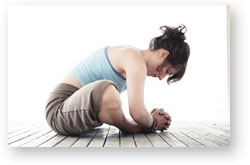When you plan time for your fitness workouts, do you take the time to stretch?
 It seems like the priority for exercise is always to get a good long cardio session in and make it all the way through a strength training routine in the amount of time “blocked off” for a wellness program. Having any time left to spend on a cool-down or doing flexibility exercises seems to get pushed to the side or forgotten in the rush to dash back to work or make it on time to your next scheduled appointment.
It seems like the priority for exercise is always to get a good long cardio session in and make it all the way through a strength training routine in the amount of time “blocked off” for a wellness program. Having any time left to spend on a cool-down or doing flexibility exercises seems to get pushed to the side or forgotten in the rush to dash back to work or make it on time to your next scheduled appointment.
Stretching is a Vital Part of a Well-Balanced Workout Program
The benefits of stretching are many, here are just a few:
- Increase Muscle Flexibility
- Improve the Range of Motion Available for Your Joints
- Improve Balance and Body Control
- Reduce the Risk of Injury
- Promote Better Posture
- Improve Circulation and Blood Flow
- Relieve Stress
Basic Tips for Stretching Safely
- Be sure you include stretches for all your major muscle groups. It’s important to stretch your whole-body. Focus on the muscles you used during your fitness workout, and include stretches that are beneficial for the muscles and joints you use regularly at work and play.
- It’s ideal to stretch before and after your fitness workouts.
- For best benefits your muscles should be warmed up before you begin stretching. At the beginning of your workout walk or do about five minutes of low intensity activity to get you moving – then take some time to stretch and continue into your workout. This will help reduce your chance of injury or “pulling” a muscle.
- It’s really important to take time to stretch AFTER your workouts! This is when your muscles are the most warmed up and receptive to increasing your flexibility. Plan at least 10 – 15 minutes or longer after the aerobics and strength training portions of your workout to focus on your flexibility.
- Avoid ballistic stretching. “Bouncing” in a stretch can cause tearing in the muscle, and may have you forcing into a stretch farther than your body really wants to go, which might result in an injury! Just hold a tolerable position, and enjoy.
- Breathing and focusing on feeling the tension in your muscles relax and let go is a very important part of increasing your flexibility and improving range of motion. Avoid holding your breath, and making funny faces as this will only increases your muscle tension!-Steady, regular breathing will help the body to release tension so your muscles can stretch even farther.
- Only stretch in a pain-free range of motion. Stretching tight muscles may feel a bit uncomfortable, but it should never hurt. If you feel pain, back off a bit, focus on your breathing, and releasing tension. As the muscle let’s go, you may be able to slowly work into a deeper position for more of a stretch.
- Hold each stretch for 30 to 60 seconds. You can use a clock, or count your breaths. 4-10 slow deep breaths will have you in a focused stretch for an appropriate length of time.
- Be sure to stretch the whole body, and do things evenly on both sides. (if you have particular muscles that are noticeably tighter from one side to the other – repeat your stretches on the tighter side until, over time both sides feel a similar amount of stretch when your exercising.
When, Where, and How Often Should I Stretch?
YOU CAN REALLY DO STRETCHING EXERCISES ANY TIME, ANY PLACE, AND AS OFTEN AS YOU FEEL THE NEED!
When to Stretch:
- Stretching should be done before and especially after any fitness workout.
- You can stretch anytime, even if you haven’t done any other type of exercise.
- Gentle stretching can be beneficial in the morning to help get you moving.
- Stretching though out the day can help reduce the stress and tension created at work, school, or with daily activities.
- Stretching before you go to bed is a great way to relax and help you get to sleep.
Where Can I Stretch?
You can stretch just about anywhere…standing, seated or laying down.
- In Bed
- On a Mat or on the Floor
- In a Chair or on a Bench
- Against a Wall
- Use the Stairs
- With a Rail, Ballet Barre, or Counter
- Inside or Outside
- At Home, Work, the Park, or the Gym
How Often Should I Stretch?
- At a minimum, stretch 2-3 days a week (along with your other fitness activities!)
- Gentle stretching is something that it is safe and appropriate to do daily.
- If you have an injury, or chronic health condition, check with your physician or physical therapist, to learn how to develop the best stretching program for you!
Enjoy the GREAT Health Benefits of Stretching to Improve Your Flexibility and Quality of Life!
Health and Fitness Activities You May Enjoy
Ready to get started? Centerworks has several exercise equipment packages to help you improve your health and fitness!


0 Comments